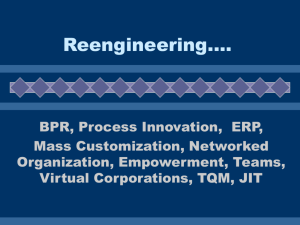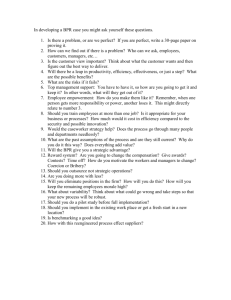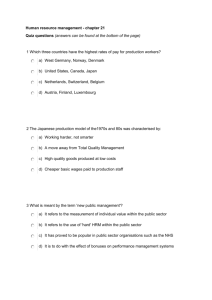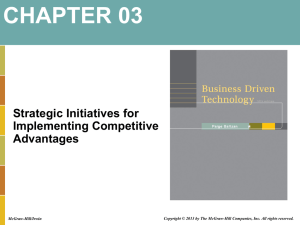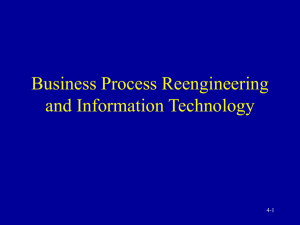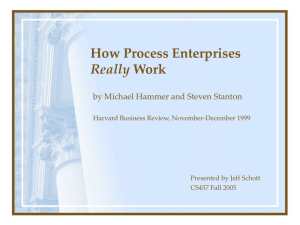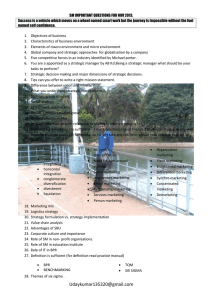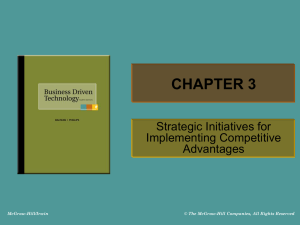Business Process Re- Engineering In The Small Firm: A Case Study
advertisement
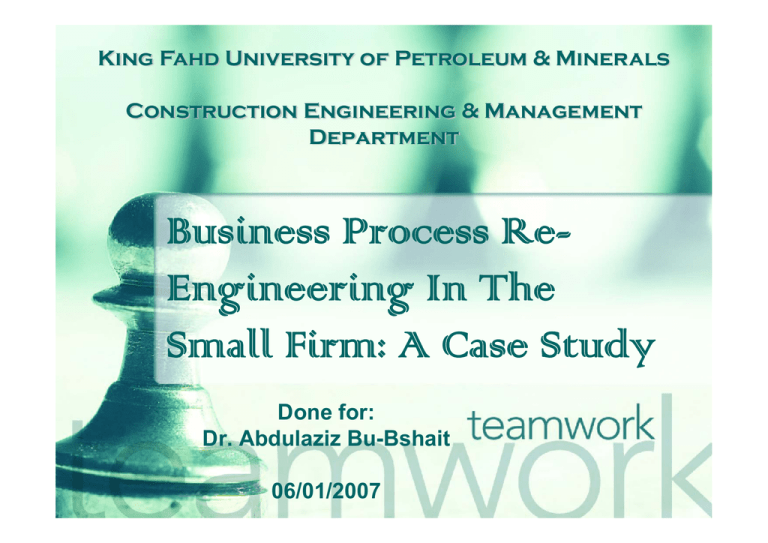
King Fahd University of Petroleum & Minerals Construction Engineering & Management Department Business Process ReEngineering In The Small Firm: A Case Study Done for: Dr. Abdulaziz Bu-Bshait 06/01/2007 INTRODUCTION Business process re-engineering (BPR) is being attempted by many firms that are looking for radical gains from the successful redesign of their processes BPR is a high risk, time consuming activity, with no guarantee of success, and yet many businesses claim to be reengineering their processes CHARACTERISTICS OF BPR radical redesign of business processes deployment of information technology as an enabler major disruption to the organization during the process of reengineering attempts at achieving organization wide improvements in performance STUDY OBJECTIVE This study attempts to provide some initial indication of the extendibility of the existing principles and methodologies in the BPR literature to the small firm In order to investigate this, a case study on a New Zealand firm consisting of four divisions was conducted THE LITERATURE GUIDANCE ON BPR Use a methodology; Explicitly define a business vision; Explicitly define process objectives; Identify processes that cover a high proportion of the business; Extensively document and measure processes being redesigned prior to redesign; Consider IT as a lever for new processes; Have managers highly involved; Consider and support employees; Evaluate after implementation. SMALL FIRMS guide-lines for small firms considering reengineering : Look at the company itself, and how it is operated Look at the market, consider how the business could change the basis of competition and protect its position Don't focus on cost reduction alone, as capability can suffer. Focus on the customer instead SMALL FIRMS Cont…. As it was not possible to include all potential factors in the investigation, the study focused in particular on the BPR methodology employed by one firm and compared this to the steps outlined by Davenport & Short (1990): The identification of critical processes within the small firm, The use of IT as a lever for reengineering The identification of a vision and objectives for the reengineering project The existence of executive commitment and organizational involvement RESEARCH APPROACH Collect case details from a small firm which has had experience with BPR Use material from the research that has significant bearing on the success of BPR outlined above, such as structure, deployment of IT and management support, to identify differences specific to the small firm Extract relevant concepts from these streams and compare these to the initial findings in the case study THE CASE STUDY The firm (New Zealand firm) consists of four divisions under a central managing director at the 'head office'. The firm has approximately 100 employees The Problem -- Poor Profitability During the 1980's, the New Zealand Government deregulated much of the New Zealand economy and the electrical supply industry became market oriented The firm responded by changing its structure to align itself more with how products were sold rather than the type of product The Problem -- Poor Profitability Cont.. The firm subsequently split into three strategic business units (SBU's), and later acquired a fourth (Electronics) the company became increasingly inefficient. As the managing director stated "processes do not remain static, and thus inefficiency grows.” Within the divisions, profitability was declining and employees were consistently inundated with work The Solution -- Role Restructuring the firm decided to undergo what was called "role restructuring" In this stage, the efforts were led initially by the managing director and the external consultants remained as facilitators rather than leaders The Solution -- Role Restructuring Cont…. In the Manufacturing division the general manager provided the support for employees in working towards the team approach. The general manager then transferred to Electronics which had not responded to the role restructuring in the same positive manner as Manufacturing. The same process was repeated and aimed at solving the more fundamental problems that had been glossed over in the first attempt. Electronics has since shown similar improvements to Manufacturing. The Solution -- Role Restructuring Cont…. an extremely flat management structure was implemented with clearly defined tasks and an organizational culture of teams and high information sharing. Administration was affected to a greater degree than the production departments The Solution -- Role Restructuring Cont…. To emphasize the flat structure within the organization, the title of "manager" is now only used for general managers and above Some others who had previously had the title Manager are now "team leaders" who, among others, report directly to their general manager General managers have taken on a "resource provider" role, rather than a decision maker role The Solution -- Role Restructuring Cont…. Role restructuring clarified the processes of the business, eliminated inefficiencies and handover delays and generally improved the organization of the business teams were formed from individuals who previously communicated frequently, meaning individuals knew when and where to seek assistance The Solution -- Role Restructuring Cont…. individuals knew when and where to seek assistance Individuals were given greater responsibility for specific tasks This responsibility was re-enforced by each person having their own operating budget and performance targets Information sharing was another important part of the role restructuring THE ROLE RESTRUCTURING PROCESS Formulation of a mission statement and long term vision Envision new processes Identify IT levers Redesign of the chosen processes Initiate change Implementation Evaluation CONCLUSIONS The aim of looking at the approach of a small firm in applying BPR was to provide an initial indication of the possibility (and necessity) of developing a methodology specifically for the small firm Overall, the steps and principles adopted by the firm show a high similarity to the recommendations made in the literature Additionally, the reengineering proved extremely successful for the group. While these conclusions can not be generalized to all small firms without further investigation

